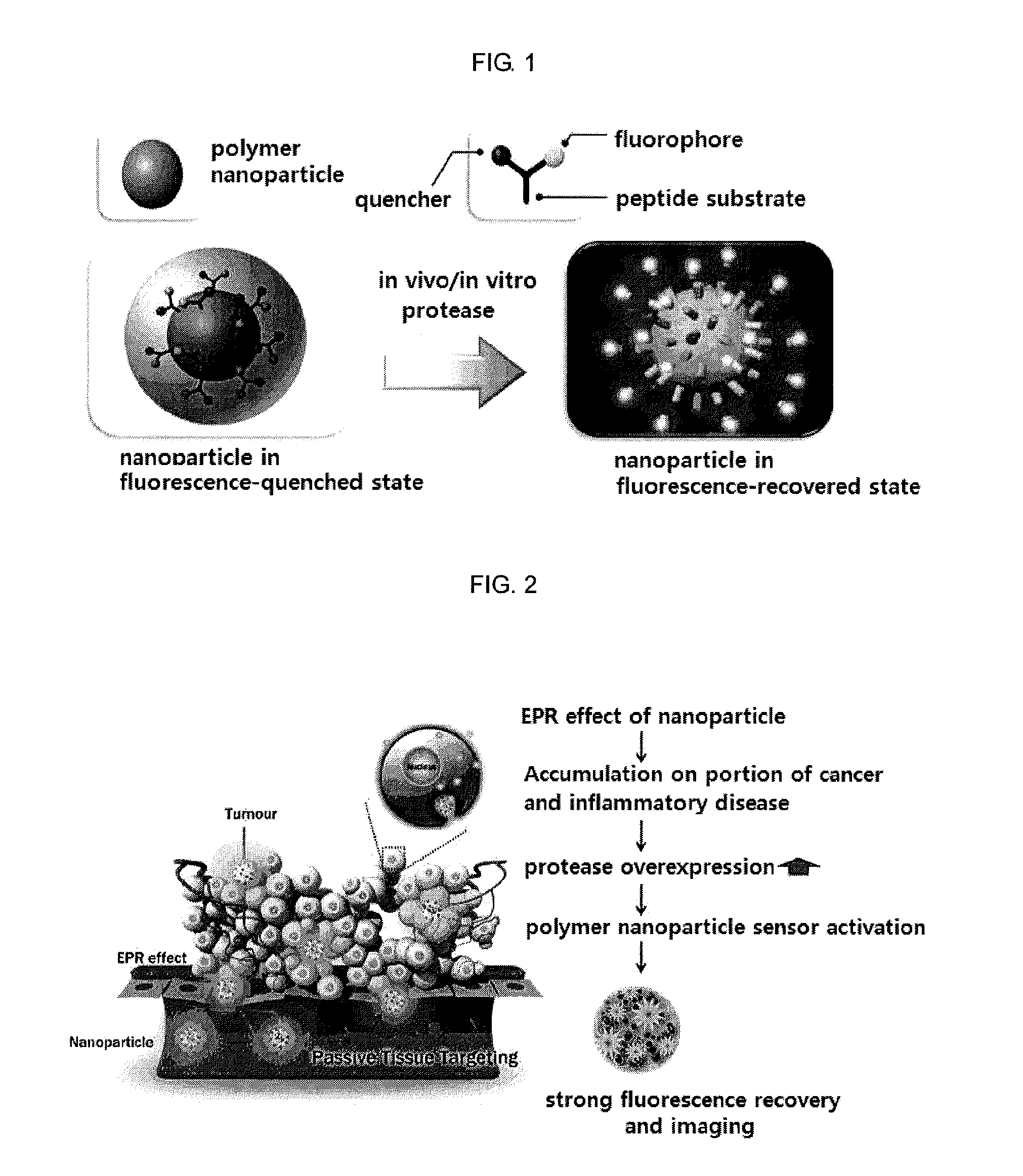Nanoparticle sensor for measuring protease activity and method for manufacturing the same
a technology of protease activity and nanoparticles, applied in the field of nanoparticle sensors for measuring protease activity, can solve the problems of insufficient introduction of quantitative imaging and analysis technology of specific proteases or non-invasively imaging the expression level of proteases in vivo, and the need for developing related techniques is urgently needed. , to achieve the effect of inhibiting fluorescence emission and high extinctive activity
- Summary
- Abstract
- Description
- Claims
- Application Information
AI Technical Summary
Benefits of technology
Problems solved by technology
Method used
Image
Examples
example 1
Preparation of Fluorophore-Peptide-Quencher-Nanoparticle Derivative
[0084]1-1. Preparation of Fluorophore-Peptide-Quenching Derivative
[0085]First, to prepare a fluorophore- and quencher-conjugated peptide, the peptide was prepared by Fmoc strategy according to a solid phase synthesis, and the fluorophore and the quencher were chemically conjugated to the prepared peptide sequence.
[0086]As the fluorophores, Cy5.5 (ex / em, 670 / 690), TRITC (ex / em, 547 / 572) and FITC (ex / em, 490 / 520) were used. As the quenchers for quenching fluorescence emitted from each of Cy5.5, TRITC and FITC fluorophores, BHQ-3 (abs. 620 nm-730 nm), BHQ-2 (abs. 550 nm-650 nm) and BHQ-1 (abs. 480 nm-580 nm) (Biosearch Technologies Inc.) were used, respectively.
[0087]As one example, a process of synthesizing a fluorophore-peptide-quencher, which emitted fluorescence by being selectively lysed by MMP-2, was as follows (see FIG. 3).
[0088]NH2-Gly-Pro-Leu-Gly-Val-Arg(Pbf)-Gly-Lys(Boc)-Gly-Gly-COOH (SEQ ID NO: 1) as a peptid...
experimental example 1
Variation of Optical Properties of Protease Sensor by MMP-Specific Lysing
[0100]Specific selectivities for proteases of the polymer based sensors, which was prepared in Example 1 and specific to MMPs, were observed. Each of the sensors (PN1, PN2 and PN3) was added in a mixture containing proteases, thereby measuring fluorescent intensities (FIs) recovered according to time.
[0101]In detail, PN1, PN2 and PN3 (10 μg / Ml each), which specifically reacted with MMPs to recover fluorescence, were added in MMP-2, MMP-3, MMP-7, MMP-9 or MMP-13 (1 μg / Ml) all in an active state, and emission of fluorescence by zymolysis was observed. For activating each MMP, the MMPs were added in TCNB solution (0.1 M of Tris, 5 mM of calcium chloride, 200 mM of NaCl and 0.1% of brij), in which p-aminophenyl mercuric acid were mixed, followed by reaction at 37° C. for 1 hour. The activated MMPs respectively reacted with a polymer nanoparticle based sensor in 200 μl of solution in a 96-well at 37° C., thereby obs...
example 2
Fluorescence Recovery and Imaging of Protease Activity Measuring Sensor According to Concentration of Protease
[0108]The sensors prepared in Example 1 were used to quantitatively analyze concentrations of proteases. In detail, according to the same method as in Example 1, activated MMP-2s respectively in concentrations of 0, 0.55, 1, 3, 7 and 14 nmol / L were added in the PN1 sensor and reacted with each other at 37° C. for 60 minutes, thereby observing emission levels of fluorescence (fluorescent intensities) using a fluorescence spectrometer and a digital imaging system (Kodak Image Station 4000 mM).
[0109]As shown in FIG. 5A, fluorescence emitted from the PN1 sensor was increased in proportion to the concentration of the added MMP-2 protease. It was thusly proved that a specific protease concentration within a specimen could be quantitatively detected by measuring the fluorescence intensity of an experimental group, and imaging thereof could be carried out using an optical imaging sy...
PUM
| Property | Measurement | Unit |
|---|---|---|
| wavelengths | aaaaa | aaaaa |
| wavelengths | aaaaa | aaaaa |
| wavelengths | aaaaa | aaaaa |
Abstract
Description
Claims
Application Information
 Login to View More
Login to View More - R&D
- Intellectual Property
- Life Sciences
- Materials
- Tech Scout
- Unparalleled Data Quality
- Higher Quality Content
- 60% Fewer Hallucinations
Browse by: Latest US Patents, China's latest patents, Technical Efficacy Thesaurus, Application Domain, Technology Topic, Popular Technical Reports.
© 2025 PatSnap. All rights reserved.Legal|Privacy policy|Modern Slavery Act Transparency Statement|Sitemap|About US| Contact US: help@patsnap.com



